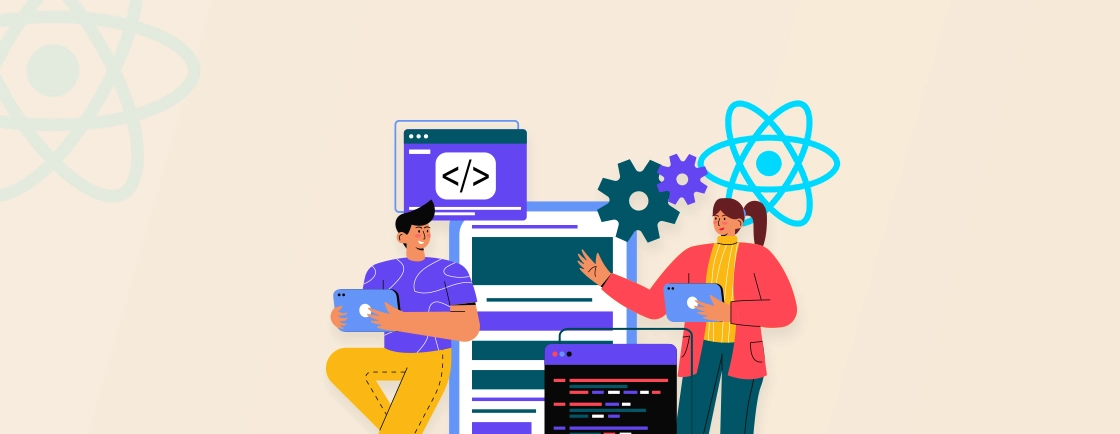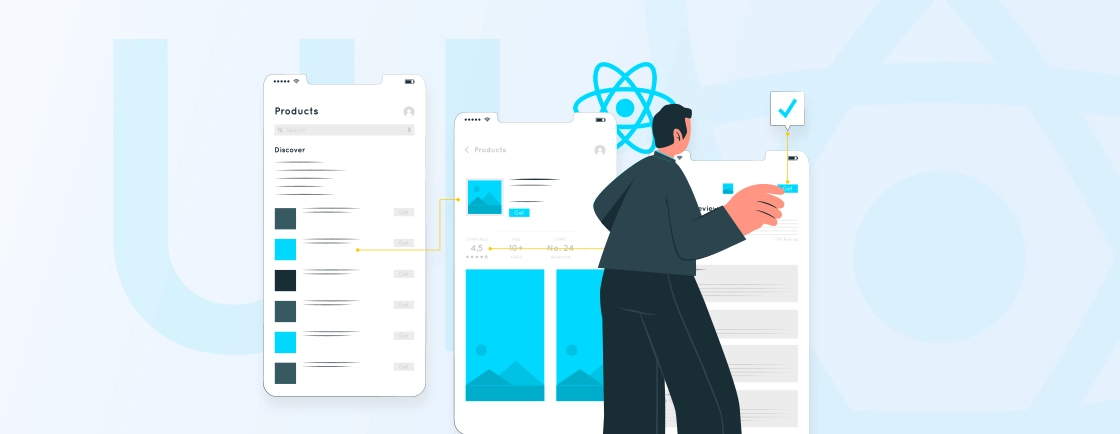Table of Contents
Imagine ordering coffee through an app that predicts your usual order before you even tap the screen. That is based on time of the day and previous orders. React Native paired with AI can help you make such intelligent, cross-platform mobile apps.
With AI and ML integrated into React Native, you can build faster, smarter apps focused on UX, performance, and automated decisions. And all this while maintaining a single codebase for iOS and Android.
This blog focuses on React Native AI apps. I’ll show you how the React Native experts build AI apps for applications like chatbots, image recognition, and more. Let’s begin.
Artificial Intelligence & Machine Learning in React Native
At present, AI and ML control the lay of the land in technology. Are you making a healthcare diagnostics app, eCommerce app, or something else that may require predictive analysis? In that case, AI and ML will underpin the technology, no matter the mobile app development platform.
React Native’s flexibility and cross-platform capabilities make it an ideal framework for integrating AI and ML. You can have cloud-based APIs and pre-trained models to add intelligent features without an impact on performance.
On-Device AI with TensorFlow Lite & ML Kit
React Native supports TensorFlow Lite and Firebase ML Kit, allowing apps to run AI models directly on smartphones—enabling real-time text recognition, face detection, and barcode scanning without constant internet connectivity.
Smart Chatbots & NLP Integration
Natural Language Processing (NLP) libraries like Dialogflow or OpenAI’s API enable React Native apps to understand and respond to user queries conversationally, improving customer support and engagement.
Predictive Analytics & Personalization
Machine learning models can analyze user behavior to predict preferences, recommend content, or automate decisions—such as dynamic pricing in e-commerce or personalized fitness plans in health apps.
Computer Vision for Enhanced UX
From augmented reality (AR) filters to document scanning, React Native apps can integrate computer vision libraries (OpenCV, VisionCamera) to process images and videos in real time.
Voice & Speech Recognition
With speech-to-text and text-to-speech APIs (e.g., Google Speech-to-Text), React Native apps can support voice commands, transcription, and accessibility features seamlessly.
With these AI/ML capabilities paired with React Native, you can bridge the gap between cutting-edge technology and seamless user experiences.
Why Use AI & ML in React Native Apps?
Artificial intelligence and machine learning can help build smarter, more competitive mobile apps. React Native, with its cross-platform efficiency, becomes even more powerful when enhanced with AI capabilities.
Smarter User Experiences
AI enables apps to learn from user behavior, offering personalized recommendations, dynamic content, and predictive actions. Like, suggesting products, workouts, or news based on past interactions.
Enhanced Efficiency & Automation
ML models can automate repetitive tasks, such as sorting data, moderating content, or processing images. That means less manual effort and improved app performance.
Real-Time Decision Making
From fraud detection in fintech apps to instant language translation in travel apps, AI can be helpful. Then React Native apps can process and respond to data instantly, improving usability and security.
Improved Engagement with NLP & Chatbots
AI-powered chatbots and voice assistants (using tools like Dialogflow or OpenAI) make customer support faster and more intuitive. That keeps users engaged without human intervention.
Offline AI Capabilities
You can have on-device ML via TensorFlow Lite or Core ML. With that, React Native apps can perform tasks like text recognition, object detection, or speech processing even without an internet connection.
Competitive Advantage
Businesses that leverage AI in their apps stand out by offering cutting-edge features. Like, AR try-ons in eCommerce or AI-based fitness coaching. It drives higher user retention and satisfaction.
With AI/ML, React Native apps can adapt, learn, and deliver exceptional value. But for the best results, consult with a professional React Native app development company.
Prerequisites for Building React Native AI Apps
First and foremost, you’ll need a strong foundation in both mobile app development and machine learning concepts. Then, you can go about taking care of the pre-requisites.
TensorFlow
To integrate machine learning into React Native apps, TensorFlow is a must-know framework. Its lightweight version, TensorFlow Lite, is optimized for mobile devices. That enables on-device AI for tasks like image classification, object detection, and natural language processing.
With React Native bindings available, developers can deploy pre-trained models or customize them for app-specific needs. Whether for a smart camera app or a real-time translator, TensorFlow is what you need.
Inception
Google’s Inception is a powerful pre-trained convolutional neural network (CNN) model. It’s perfect for image recognition tasks in React Native apps. Instead of training a model from scratch, developers can fine-tune Inception for specific use cases. Like, identifying objects, scenes, or even user emotions from photos.
Here are the components to integrate the AI with React Native.
- TensorFlow for React Native: npm i @tensorflow/tfjs-react-native
- React Native Caffe2: npm i react-native-caffe2
- React Native CoreML: npm i react-native-coreml
- React Native Image ML: npm i react-native-core-ml-image
Combined with TensorFlow Lite, Inception allows React Native apps to perform complex visual analysis efficiently. That makes it ideal for eCommerce, healthcare, and social media applications.
How to Build a React Native AI App?
After you have taken care of the pre-requisites shown above, it’s time to build the AI-focused React Native app. The process will start with project configuration.
Step 1: Set Up and Configure the Project
First off, go to the root directory of your project and create a file named ‘rn-cli.config.js’. Then, configure it including the TensorFlow model with this code.
module.exports = {
getAssetExts() {
return ['pb', 'txt'];
}
}
- pb (model file): extension of the output model
- txt (label file): extension of the label file
Step 2: Add TensorFlow Model to Assets
Next up, find your application’s assets folder and place the TensorFlow model file to enable image recognition. Now this model can be accessed and used for accurate image recognition.
tensorflow_inception_graph.pb
Now, you can verify file loading for the app:
const modelPath = require('./assets/tensorflow_inception_graph.pb');
Step 3: Add Label File to Assets
AI models classify objects based on label mappings. Prepare a .txt file with one label per line. Here’s the code excerpt.
tensorflow_labels.txt
Step 4: Initialize the tfImageRecognition API Class
After creating a model and label, create a class to manage model loading and inference. Use the following card to initialize the ‘tfImageRecognition’ API class.
const tfImageRecognition = new tfImageRecognition({
model: require(‘./assets/tensorflow_inception_graph.pb’),
labels: require(‘./assets/tensorflow_labels.txt’),
});
Step 5: Implement the Recognize Function
Final step of the process involves running predictions on input data (eg. an image). You can use a training set to train the model for recognizing images.
const results = await tfImageRecognition.recognize({
image: require('./assets/panda.jpg'),
});
After running this code, update UI with the AI’s prediction.
If you want help with running this process for best results, consult with our React Native app development company.
Best Practices for React Native AI App Development
Integrating AI into React Native apps can help ensure some powerful capabilities. But for the best results with respect to optimal performance, accuracy, and user experience, follow these practices.
Optimize Model Size for Mobile
Mobile devices have limited storage and memory—avoid bloated AI models. Use quantization (reducing model precision from 32-bit to 8-bit) and pruning (removing redundant neurons) to shrink file sizes.
Tools like TensorFlow Lite Converter help compress models without significant accuracy loss. A smaller model ensures faster load times and smoother performance, especially on low-end devices.
Prioritize On-Device AI Over Cloud APIs
Cloud-based AI (e.g., Google Vision) offers powerful features. And on-device inference (via TensorFlow Lite or Core ML) improves speed, privacy, and offline functionality. Reserve cloud APIs only for complex tasks requiring heavy computation, like real-time video analysis.
Cache Predictions for Repeated Tasks
Does your app frequently process the same input (e.g., scanning barcodes or classifying common objects)? Then you need to cache predictions to avoid redundant model runs. Store results in AsyncStorage or a local database to reduce latency and improve responsiveness.
Handle Edge Cases Gracefully
AI models can fail—blurry images, low-light conditions, or unexpected inputs should trigger fallback mechanisms. Use placeholder suggestions, error toasts (“Try a clearer photo”), or secondary verification (e.g., “Did you mean X?”) to maintain usability.
Optimize UI for AI Interactions
AI features should feel intuitive. Use skeleton loaders during model inference, real-time previews, and progressive disclosure. Avoid blocking the UI thread—run heavy computations in background threads.
Test Across Devices & OS Versions
Model performance varies across devices (e.g., iPhones vs. budget Androids). Test:
- Speed: Inference time on older devices.
- Accuracy: Model behavior under different OS versions.
- Memory Usage: Monitor crashes due to excessive RAM consumption.
Secure Sensitive AI Workloads
If your app processes private data (like face recognition), encrypt model files and uses secure environments. You can do it through something like Android’s Trusted Execution or iOS’s Secure Enclave. Avoid hardcoding API keys—fetch them dynamically at runtime.
Monitor & Update Models Post-Deployment
AI models degrade over time (data drift, new edge cases). Implement:
- Analytics: Track prediction accuracy and failures.
- OTA Updates: Push new models silently via Firebase or CodePush.
- A/B Testing: Compare model versions before full rollout.
React Native AI apps thrive when balancing performance, usability, and intelligence. So consult with our React Native development experts to build AI-powered apps that are fast, reliable, and user-friendly.
Let’s Summarize
React Native has proven to be a powerful platform for building AI-driven mobile applications. It combines cross-platform efficiency with cutting-edge machine learning capabilities. From real-time image recognition to smart chatbots, AI in React Native apps can ensure better user engagement and automation.
Leveraging AI can extend the platform’s flexibility and you can create apps that aren’t just functional, but truly intelligent.
So, want to create an intelligent and high-performing AI-powered app with React Native? Hire React Native app developer to turn your vision into a smart, scalable mobile solution.
FAQs on React Native AI App
Is on-device AI better than cloud-based AI?
On-device AI is faster, works offline, and enhances privacy. Cloud AI is better for heavy tasks (e.g., NLP with GPT-3). A hybrid approach (e.g., offline fallback + cloud sync) often works best.
Can React Native handle AI/ML models efficiently?
Yes! With libraries like TensorFlow.js, React Native ML Kit, and ONNX Runtime, React Native can run lightweight AI models directly on devices. For complex tasks, you can offload processing to cloud APIs (e.g., AWS SageMaker, Google Vertex AI).
Can I use OpenAI/ChatGPT in React Native?
Yes! You can integrate OpenAI’s API for chatbots (using react-native-gpt3), text summarization, and code generation (eg. GitHub Copilot-like features).
How does React Native handle AI model compatibility across iOS and Android?
React Native bridges native AI frameworks (Core ML for iOS, ML Kit for Android) through JavaScript interfaces. Libraries like react-native-mlkit provide unified APIs, ensuring consistent behavior.
For TensorFlow Lite models, the same .tflite file typically works on both platforms with minimal platform-specific tuning.
How do permissions work for AI features like camera/microphone?
React Native’s PermissionsAndroid and iOS Info.plist settings control access. For sensitive features (e.g., face recognition), explain usage in your app’s privacy policy to comply with GDPR/CCPA.
Build Cross-Platform React Native Apps
Discover how to create cross-platform mobile applications using React Native.





